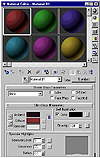| ISO 9000 | ISO 14000 |
 GMP Consulting |
Understanding Specialized User Interface ToolsWe have covered many different areas in the user interface (UI) to this point. You will use some of the areas we’ve discussed every time you open up 3D Studio MAX. For example, to move and view your scene you will have to know and use the navigation tools. Eventually you will use items such as the Transform tools and the Move, Rotate, and Scale commands without even thinking about them. But there are also some areas of the UI that are a bit more specialized and more complex in their usage, including the Time Control, Material Editor, and Track View. The following sections will provide you with an introduction to these areas. Each one will be discussed in greater detail later in the book. Using the Time Control AreaThe Time Control area (Figure 3.17) is located on the lower-right area of the UI next to the viewport navigation tools. The Time Control area holds tools that can play and configure your animation.
This area contains buttons that allow you to record your animation. Once you have recorded your animation, you can use the remaining icons to move through it: Go to Start, Go to Previous Frame, Play Animation, Go to Next Frame, and Go to End of the Animation. You can also use the Time Slider to scroll through your animation. You will notice two numbers on the Time Slider (Figure 3.18). The first number indicates the current frame; the second number indicates the total number of frames in the active segment of your animation.
Using the Material EditorThe Material Editor (Figure 3.19) is the “dressing room” for your scene. After you have created your 3D objects, you can change their appearance by applying various colors and textures to them to give your scene a more realistic appearance. With the Material Editor you can use the pre-made materials that come with MAX. There are metals, stones, and wood materials to choose from, as well as colors and fabrics. If you don’t find anything to your liking, you can create your own unique material or adjust the pre-made materials. The Material Editor can be opened in several ways. You can use the icon on the Main Toolbar, you can launch it from the Tools menu, or youс can simply press the M key.
Using the Track ViewThe Track View allows you to better control your animation sequences as well as your overall scene management (Figure 3.20). You have more controls to adjust your animation with using the Track View. The Track View is broken down into certain areas. On the left side it holds all the different components of your scene. Each component holds a specific type of animation in its rollout. The large middle area is where your keys would be available to work on. Across the top and bottom of the layout are several icons that will assist you in viewing and manipulating your keys and animations.
SummaryAs you can clearly see, the MAX user interface can seem overwhelming, but it is important to remember that you do not have to know everything in the UI. It will take some time to remember where things are located, but that’s OK. Just take your time and have fun. Remember that this is an ongoing learning process. Now that you have knowledge of the pull-down menus, Shelf Area, the Command Panel, how to customize and navigate the UI, and a foundation for tackling MAX, it’s time to move on to the modeling tools, beginning with polygonal modeling in the next chapter.
© 2000, Frol (selection, edition, publication) |
|
|

